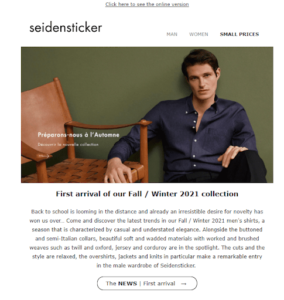You might think that it is wasteful to spend a couple of hours trying to find the right font for your email. Well, let me assure you that it’s not. Fonts can be a make-or-break factor in your email marketing campaign. Even if you have poured your heart out while designing the mail, if the fonts are illegible, things will not turn out to be as you wished them to be. Hence, here is a guide for email typography.
How to choose the ideal font for your email?
Before choosing a font for your email, ensure that it fulfills the conditions given below-
-
Is the font readable?
The typography that you are choosing should be legible. People opening the email should be able to easily skim through the content. You might want to stay away from the fonts like Vivaldi and Papyrus. Next, the fonts should be of the appropriate size. The headings and the subheadings should be slightly larger compared to the font in the main body of the email. Lastly, you should check the spacing between the fonts. If the lines are too close together, people might end up reading the same line twice. Also, select a font that is universally supported by the various devices.
-
Is the font neutral?
A neutral font means that the fonts should seamlessly blend with the message which you are trying to send through the email. Fancier fonts will draw the attention of the reader elsewhere, and they might miss the important buttons. For example, Helvetica is known as the epitome of neutral fonts.

-
Does the font do justice to your brand image?
Good typography gives voice to your brand. The font that you are using should be in accordance with your brand’s aesthetics and should justify a level of professionalism. Garamond font is one such example of a formal font. Big corporations should absolutely stay away from fonts like Comic Sans MS.
Also Read: Movierulz.com| Movierulz ms, pz, pe, plz | Latest New Updated Links | HD Movies Download
What are the different font families?
Fonts are divided into two categories- Web-safe fonts and Web fonts.
-
Web-safe Fonts
Web-safe fonts are the typefaces that are already installed by default in most operating systems. These are also called email safe fonts, as the emails will be presented in the way they were meant to be seen. The web-safe fonts are further divided into Serif and Sans Serif.
The letters of the Serif font family all have a tail or small flourishes or shapes at the end. Sans Serif means without a tail and does not have the fancy flourishes attached to them. Sans Serif often looks more formal and is widely used. Georgia and MS Serif are examples of the Serif group whereas Arial, Tahoma, and Verdana are examples of Sans Serif fonts.
The problem with widely used fonts is that they are too common. You also have only a few options to select from. Most of the free HTML email templates also use web-safe fonts.
-
Web Fonts
If you want access to a wider variety of fonts, you will have to dip into the pool of Web fonts. Web fonts will only show up on the systems that have them installed. Nowadays, some browsers have web fonts embedded into them. Otherwise, you will need to download them to your system.
The web fonts are divided into Monospace and Calligraphy fonts. The monospace fonts are inspired by the typewriter font. The letters have a recognizable slab at the end of their strokes. However, Monospace fonts are not often used in free HTML email templates. Yet, they are the default “fallback fonts” for the other fancier custom fonts. On the other hand, the Calligraphy fonts family are inspired by the flow of cursive handwriting. They are fun to read on paper and other print mediums, but they might be difficult to decipher on a digital screen.
Sophia and Molina are examples of Calligraphy fonts, and Monaco and Courier are examples of Monospace fonts.

Also Read: Content://com.avast.android.mobilesecurity/ temporarynotifications
Can you have a custom font for your emails?
Thousands of fonts are available online. More often than not, you will find the one that suits your business aesthetics. In such a case, you will have to choose your custom font as the primary font and another font as a “fallback font”. A fallback font is a web-safe font that will be utilized if the custom font is not installed on the recipient’s desktop. You can add multiple fallback fonts to protect the aesthetics of your business marketing emails. Be careful as Outlook is infamous for overriding the fallback commands and displaying the email text in Times New Roman.
What are the other things that you should keep in mind while using custom fonts?
Ensure that line spacing is properly done and the text can be easily read. You can use two types of fonts, one for the headings and one for the remainder of the content. Make sure that secondary fonts belong to the family of the primary fonts. Other than that, you are free to play with the colors of the letters, different formatting, alignments, and background colors. Just don’t get too crazy and type a light gray letter on a white background.
For a deeper understanding of how to hit the bull’s eye with your typography, check out this comprehensive infographic – Typography in emails.
Conclusion
While designing your email template, you should first find the fallback font to ensure that your aesthetics remain unchanged. Then you can take your time to find your custom font as this is worth the effort. You can start today by playing around with different fonts, treading carefully of course








